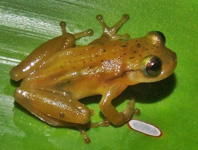Abstract
The present study describes a new species of Vulcanolepas from the Lau Basin in the South Pacific. The basal angle of the tergum of Vulcanolepas buckeridgei sp. nov. is elevated from the capitular-peduncular margin at ~1/6 of the capitular height. The mandibles of V. buckeridgei sp. nov. are tridentoid; the cutting margins of the second and third teeth are long and each tooth possesses 18–20 sharp spines. The proximal segments of the anterior and posterior rami of cirrus I are protuberant and with dense, simple setae. DNA barcode sequences of Vulcanolepas buckeridgei sp. nov. are similar to Vulcanolepas sp. 1 collected from the Lau Basin (Herrera et al. 2015). Vulcanolepas buckeridgei is morphologically similar to Vulcanolepas ‘Lau A’ collected in the Lau Basin (Southward & Newman 1998). This suggests that Vulcanolepas buckeridgei sp. nov. is widespread in the Lau Basin.
References
Buckeridge, J.S. (1983) The fossil barnacles (Cirripedia: Thoracica) of New Zealand and Australia. New Zealand Geological Survey Paleontological Bulletin, 50, 1–152.
Buckeridge, J.S. (2000) Neolepas osheai sp. nov., a new deep-sea vent barnacle (Cirripedia: Pedunculata) from the Brothers Caldera, south-west Pacific Ocean. New Zealand Journal of Marine and Freshwater Research, 34, 409–418.
https://doi.org/10.1080/00288330.2000.9516944Buckeridge, J.S., Linse, K. & Jackson, J.A. (2013) Vulcanolepas scotiaensis sp. nov., a new deep-sea scalpelliform barnacle (Eolepadidae: Neolepadinae) from hydrothermal vents in the Scotia Sea, Antarctica. Zootaxa, 3745 (5), 551–568.
https://doi.org/10.11646/zootaxa.3745.5.4Chan, B.K.K., Hoeg, J.T. & Garm, A. (2008) Setal morphology and setation patterns of barnacle cirri: adaptations and implications for thoracican evolution. Journal of Zoology, London, 275, 294–306.
https://doi.org/10.1111/j.1469-7998.2008.00441.xDesbruyères, D., Alayse-Danet, A., Ohta, S. & Scientific parties of BIOLAU and STARMER cruise. (1994) Deepsea hydrothermal communities in southeastern Pacific back-arc basins (the North Fiji and Lau Basin), Composition, microdistribution and food web. Marine Geology, 116, 227–242.
https://doi.org/10.1016/0025-3227(94)90178-3Folmer, O., Black, M., Hoeh, W., Lutz, R. & Vrijenhoek, R. (1994) DNA primers for amplification of mitochondrial cytochrome c oxidase subunit I from diverse metazoan invertebrates. Molecular Marine Biology and Biotechnology, 3, 294–297.
Herrera, S., Watanabe, H. & Shank, T.M. (2015) Evolutionary and biogeographical patterns of barnacles from deep-sea hydrothermal vents. Molecular Ecology, 24, 673–689.
https://doi.org/10.1111/mec.13054Huelsenbeck, J.P. & Ronquist, F. (2001) MRBAYES: Bayesian inference of phylogenetic trees. Bioinformatics, 17, 754–755.
https://doi.org/10.1093/bioinformatics/17.8.754Kearse, M., Moir, R., Wilson, A., Stones-Havas, S., Cheung, M., Sturrock, S., Buxton, S., Cooper, A., Markowitz, S., Duran, C., Thierer, T., Ashton, B., Mentjies, P. & Drummond, A. (2012) Geneious Basic: an integrated and extendable desktop software platform for the organization and analysis of sequence data. Bioinformatics, 28 (12), 1647–1649.
https://doi.org/10.1093/bioinformatics/bts199Kumar, S., Stecher, G. & Tamura, K. (2016) MEGA7: Molecular evolutionary genetics analysis version 7.0 for bigger datasets. Molecular Biology and Evolution, 33, 1870–1874.
https://doi.org/10.1093/molbev/msw054Larkin, M.A., Blackshields, G., Brown, N.P., Chenna, R., McGettigan, P.A., McWilliam, H., Valentin, F., Wallace, I.M., Wilm, A., Lopez, R., Thompson, J.D., Gibson, T.J. & Higgins, D.G. (2007) Clustal W and Clustal X version 2.0. Bioinformatics, 23, 2947–2948.
https://doi.org/10.1093/bioinformatics/btm404Newman, W.A. (1979) A new scalpellid (Cirripedia) ; a Mesozoic relic living near an abyssal hydrothermal spring. Transactions of the San Diego Society of Natural History, 19 (11), 153–167.
Newman, W.A. & Hessler, R.R. (1989) A new abyssal hydrothermal verrucomorphan (Cirripedia; Sessilia): the most primitive living sessile barnacle. Transactions of the San Diego Society of Natural History, 21, 259–273.
https://doi.org/10.5962/bhl.part.24587Southward A.J. (2005) Systematics and ecology of a new species of stalked (Cirripedia: Thoracica: Scalpellomorpha: Eolepadidae: Neolepadini) from the Pacific-Antarctic Ridge at 38°S. Senkenbergiana Maritima, 35,147–156.
https://doi.org/10.1007/BF03043683Southward, A.J. & Jones, D.S. (2003) A revision of stalked barnacles (Cirripedia: Thoracica: Scalpellomorpha: Eolepadidae: Neolepadinae) associated with hydrothermalism, including a description of a new genus and species from a volcanic seamount off Papua New Guinea. Senckenbergiana Maritima, 32, 77–93.
https://doi.org/10.1007/BF03043086Southward, A.J. & Newman, W.A. (1998) Ectosymbiosis between filamentous sulphur bacteria and a stalked barnacle (Scalpellomorpha, Neolepadinae) from the Lau Back Arc Basin, Tonga. Cahier de Biologie Marine, 39, 259–262.
Yamaguchi, T. & Newman, W.A. (1990) A new and primitive barnacle (Cirripedia: Balanomorpha) from the North Fiji Basin abyssal hydrothermal field, and its evolutionary implications. Pacific Science, 44, 135–155.
Yamaguchi, T., Newman, W.A. & Hashimoto, J. (2004) A cold seep barnacle (Cirripedia: Neolepdinae) from Japan and the age of the vent/seep fauna. Journal of the Marine Biological Association of the United Kingdom, 84, 111–120.
https://doi.org/10.1017/S0025315404008975h

